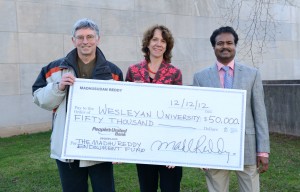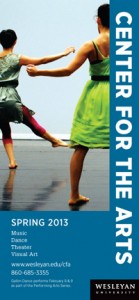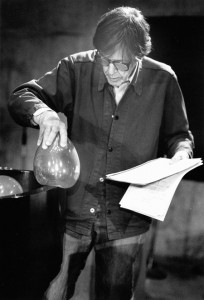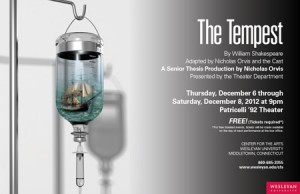
Wesleyan University’s Center for the Arts announces the creation of the Madhu Reddy Endowed Fund for Indian Music and Dance at Wesleyan University. Mr. Reddy, a real estate agent with William Raveis based in Glastonbury, Connecticut, established the fund with a pledge of $100,000 and presented a check for $50,000 to Pamela Tatge, Director of the Center for the Arts, at a brief ceremony on Friday, December 14. “For over fifty years, Wesleyan’s Music and Dance Departments and the Center for the Arts have been presenting the music and dance of India to the campus and the region. The Reddy Fund will sustain Wesleyan’s annual Navaratri Festival of music and dance, as well as provide much needed support for faculty research and performance,” said Ms. Tatge. “We are all so moved by Madhu’s generosity and passion for the arts of India, and look forward to working with him to grow the Fund in the coming years.”
Wesleyan’s program in Indian music and dance was founded by T. Viswanathan, who earned his Ph.D. at Wesleyan in 1975 and then began teaching South Indian music together with his brother T. Ranganathan. Their sister was the renowned dancer Balasaraswati, who also taught at Wesleyan. Today, Wesleyan’s Indian music and dance faculty includes Adjunct Assistant Professor of Music B. Balasubrahmaniyan, Assistant Professor Dance Hari Krishnan, and Music Artist in Residence David Nelson.
Navaratri, one of India’s major festival celebrations, is a time to see family and friends, enjoy music and dance and seek blessings for new endeavors. The annual Navaratri Festival at Wesleyan celebrates traditional Indian music and dance. The 36th annual Navaratri Festival, which took place in October and November 2012, included a concert by Mr. Balasubrahmaniyan and Mr. Nelson, along with performances by singer T.V. Sankaranarayanan and dancer Rama Vaidyanathan in Crowell Concert Hall. The 37th annual Navaratri Festival will take place in October 2013.
About the Music Department
The Wesleyan University Music Department provides a unique and pioneering environment for advanced exploration committed to the study, performance, and composition of music from a perspective that recognizes and engages the breadth and diversity of the world’s musics and technologies. As an integral part of one of the nation’s leading liberal arts institutions, the department has enjoyed an international reputation for innovation and excellence, attracting students from around the globe since the inception of its visionary program in World Music four decades ago.
A recording studio, a computer and experimental music studio, the Center for the Arts media lab and digital video facility, the World Instrument Collection (which includes the David Tudor Collection of electronic musical instruments and instrumentation) and the Scores and Recordings Collection of Olin Library (which includes the World Music Archives) offer many learning opportunities outside of the classroom.
For more information about the Music Department, please click here.
About the Dance Department
The Dance Department at Wesleyan University is a contemporary program with a global perspective. The curriculum, faculty research and pedagogy all center on the relationships between theory and practice, embodied learning, and the potential dance making has to be a catalyst for social change. Within that rigorous context, students encounter a diversity of approaches to making, practicing and analyzing dance in an intimate learning atmosphere. The program embraces classical forms from Ballet, Bharata Natyam, Javanese, and Ghanaian, to experimental practices that fuse tradition and experimentation into new, contemporary forms.
For more information about the Dance Department, please click here.
About the Center for the Arts
Wesleyan University’s Center for the Arts is an eleven-building complex on the Wesleyan campus that houses the departments of Art and Art History, Dance, Film Studies, Music, and Theater. Opened in 1973, the CFA serves as a cultural center for the region, the state and New England. The Center includes the 400-seat Theater, the 260-seat Hall, the World Music Hall (a non-Western performance space), the 414-seat Crowell Concert Hall and the Ezra and Cecile Zilkha Gallery.
The Center for the Arts gratefully acknowledges the support of its many generous funders and collaborators, including the Doris Duke Charitable Foundation, The Andrew W. Mellon Foundation, the Middletown Commission on the Arts, the National Endowment for the Arts, the New England Foundation for the Arts, the State of Connecticut Department of Economic and Community Development’s Office of the Arts, as well as media sponsors the Hartford and New Haven Advocates, Shore Publishing, WESU 88.1FM, and WNPR.
For more information about Center for the Arts, please call (860) 685-3355, or click here.




